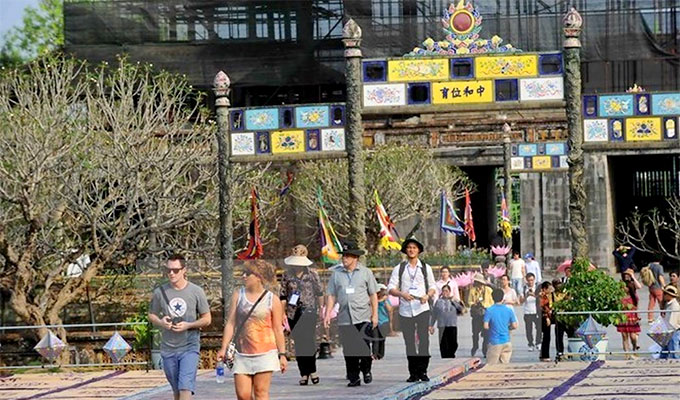The central province of Thua Thien-Hue received 3.7 million visitors during January-October, a year-on-year surge of 21 percent.

Some 1.55 million foreigners visit Hue during January-October this year
Of the total, there were 1.55 million foreigners, up 29.7 percent from the same time last year and equal to the number of international arrivals in 2017. Visitors from the Republic of Korea topped the pile, accounting for one third of the total foreign visitors. Most of them flied to Hue for sightseeing, enjoying local dishes, and shopping.
The locality also saw stable growth in number of tourists from France, Germany and the UK.
According to Nguyen Dung, Vice Chairman of the provincial People’s Committee, the province targets 4-4.2 million tourists this year, 10-12 percent higher than in 2017. Tourism revenue is expected to rise 15-16 percent year-on-year to 4-4.2 trillion VND (172 million- 180.7 million USD).
From the outset of the year, the province has carried out various activities to attract visitors, with the 10th Hue Festival in April considered the most notable event.
In February, along with lighting up the historic flag tower with 1,000 LED lights, the province installed four canon-like fire guns at the tower which can fire real shots. The gun designs resemble the canons made by the Nguyen dynasty.
The Hue Monument Conservation Centre in July launched an art programme titled “Royal Inspiration” in Hue Imperial City by night and Change of Guards ceremony at Ngo Mon Gate, creating a highlight for the Hue Imperial Palace at night.
A cultural space has been formed on Le Loi street while more food zones and art activities are arranged on Pham Ngu Lao, Vo Thi Sau and Chu Van An streets.
Particularly, a 400-metre ironwood-floored pedestrian bridge along the southern bank of Huong River is believed to woo a huge crowd of visitors.
Also, the locality has channeled focus on upgrading its tourism website in both Vietnamese and English, and making the website linked with those of the Viet Nam National Administration of Tourism and its partners to popularise local tourism.
In addition, it has paid due attention to upgrading local infrastructure and developing tourism products linking famous tourist attractions in the East-West Economic Corridor.
Hue, the formal imperial capital of Viet Nam for hundreds of years, is home to five heritages recognised by the UNESCO, including the ancient citadel relic complex- a World Cultural Heritage site, Hue royal court music- an intangible cultural heritage item, Nguyen Dynasty’s wood blocks-a documentary heritage item, Nguyen Dynasty’s royal administrative documents-part of the Asia-Pacific Register of UNESCO’s Memory of the World Programme, and literature on Hue royal architecture-a documentary heritage.
The Hue imperial citadel relic site has been ranked second among top seven tourism attractions of Viet Nam in 2017.